Heat Transfer and Thermal Management of Interior Permanent Magnet Synchronous Electric Motor
Abstract
1. Introduction
2. Electromagnetic Analysis
2.1. Design Considerations
2.2. Results of Electromagnetic Analysis with the Thermal Powers Generated
3. Thermal Analysis Methods
3.1. Heat Convection of Spiral Coolant Channels with and without Sectional Twist
3.2. Heat-Conduction Model
or NuShaft = 2.85 × 10−4Rer1.19 when Rer > 2.77 × 105
4. Results and Discussion
4.1. Convective Flow and Heat Transfer in Spiral Channels with and without Sectional Twist
4.2. Temperature Fields of Electric Motors with and without Rotor Cooling
5. Conclusions
- The present invention of the segmental spoke + V type magnet arrangement in the rotor along with the Y + Delta connection for the stator windings improved the electromagnetic efficiency and hence reduced the various power losses to moderate the thermal loads of the motor-cooling systems.
- With the sectional twists to induce the torsional forces along the newly devised twisted spiral channel, the circumferential velocity, turbulence kinetic energy and vorticity were boosted to be in favor of heat-transfer augmentations from those developed along the smooth spiral channel. At the parametric conditions of 1290 ≤ Dn ≤ 6455 or 5000 ≤ Re ≤ 25,000, the ratios were elevated to 1.18–1.09 but decreased with the increase of Dn or Re. As the flow mechanisms adjacent to the channel inner wall were modified by the sectional twist that improved the inner-wall heat-transfer properties from those in the smooth spiral channel, the outer-to-inner heat-transfer differences were considerably reduced to offer the more uniform heat-transfer distributions along the periphery of the twisted spiral channel.
- Acting with the conduction effect of the aluminum water jacket, the increase of heat-convective coefficients from the smooth spiral channel levels using the present twisted spiral channel was effective for reducing the average temperatures about 10% but less effective to alter the characteristic thermal field in the water jacket of the motor.
- With the airflow through the hollow shaft, the hot spots shifted from the inner core of the solid shaft to the outer surface of the hollow shaft with the considerable temperature reductions from those developed in the solid shafts at both rated and maximum loads.
- While the Taylor vortical flows in the rotor-to-stator air gap are inevitable, the thermal barrier formulated by the Taylor flow prohibited effective heat transmission from the rotor to stator, leading to the diminished effect of the stator cooling condition on the thermal fields in rotor and shaft and the necessities for future developments of rotor cooling in order to increase the power density of an electric motor.
Author Contributions
Funding
Acknowledgments
Conflicts of Interest
References
- Hita, Y.; Kesamaru, K.; Yoshida, K. Eddy-current loss analysis in PM of surface-mounted-PM SM for electric vehicles. IEEE Trans. Magn. 2000, 36, 1941–1944. [Google Scholar]
- Atallah, K.; Howe, D.; Mellor, P.H.; Stone, D.A. Rotor loss in permanent magnet brushless AC machines. IEEE Trans. Ind. Appl. 2000, 36, 1612–1618. [Google Scholar]
- Wrobel, R.; Mellor, P.; Popescu, M.; Staton, D. Power loss analysis in thermal design of permanent magnet machines: A review. IEEE Trans. Ind. Appl. 2016, 52, 1359–1368. [Google Scholar] [CrossRef]
- Yaohui, G.; Mohammad, K.; Yew, C.C.; James, D.W.; Xu, D.; Mircea, P.; James, G.; Dave, S.; Andrew, S. Cooling of automotive traction motors: Schemes, examples and computation methods—A review. IEEE Trans. Ind. Electron. 2019, 66, 1681–1692. [Google Scholar]
- Chang, S.W.; Chiou, S.F.; Su, L.M.; Yang, T.L. Free Convective Heat Transfer in Tilted Longitudinal Open Cavity. Heat Transf. Eng. 2005, 26, 46–64. [Google Scholar] [CrossRef]
- Farsane, K.; Desevaux, P.; Panday, P. Experimental study of the cooling of a closed type electric motor. Appl. Therm. Eng. 2000, 20, 1321–1334. [Google Scholar] [CrossRef]
- Trigeol, J.F.; Bertin, Y.; Lagonotte, P. Thermal Modeling of an Induction Machine Through the Association of Two Numerical Approaches. IEEE Trans. Energy Convers. 2006, 21, 314–323. [Google Scholar] [CrossRef]
- Nakahama, T.; Suzuki, K.; Hashidume, S.; Ishibashi, F.; Hirata, M. Cooling Airflow in Unidirectional Ventilated Open-Type Motor for Electric Vehicles. IEEE Trans. Energy Convers. 2006, 21, 645–651. [Google Scholar] [CrossRef]
- Kim, M.S.; Lee, K.S.; Um, S. Numerical investigation and optimization of the thermal performance of a brushless DC motor. Int. J. Heat Mass Transf. 2009, 52, 1589–1599. [Google Scholar] [CrossRef]
- Lim, C.; Airoldi, G.; Bumby, J.; Dominy, R.; Ingram, G.; Mahkamov, K.; Brown, N.; Mebarki, A.; Shanel, M. Experimental and CFD investigation of a lumped parameter thermal model of a single-sided, slotted axial flux generator. Int. J. Therm. Sci. 2010, 49, 1732–1741. [Google Scholar] [CrossRef]
- Li, H. Cooling of a permanent magnet electric motor with a centrifugal impeller. Int. J. Heat Mass Transf. 2010, 53, 797–810. [Google Scholar] [CrossRef]
- Lu, Y.; Liu, L.; Zhang, D. Simulation and Analysis of Thermal Fields of Rotor Multislots for Nonsalient-Pole Motor. IEEE Trans. Ind. Electron. 2015, 62, 7678–7686. [Google Scholar] [CrossRef]
- Chai, F.; Tang, Y.; Pei, Y.; Liang, P.; Gao, H. Temperature Field Accurate Modeling and Cooling Performance Evaluation of Direct-Drive Outer-Rotor Air-Cooling In-Wheel Motor. Energies 2016, 9, 818. [Google Scholar] [CrossRef]
- Chiu, H.C.; Jang, J.H.; Yan, W.M.; Shiao, R.B. Thermal performance analysis of a 30 kW switched reluctance motor. Int. J. Heat Mass Transf. 2017, 114, 145–154. [Google Scholar] [CrossRef]
- Arbab, N.; Wang, W.; Lin, C.; Hearron, J.; Fahimi, B. Thermal Modeling and Analysis of a Double-Stator Switched Reluctance Motor. IEEE Trans. Energy Convers. 2015, 30, 1209–1217. [Google Scholar] [CrossRef]
- Bianchi, N.; Bolognani, S.; Luise, F. Analysis and design of a brushless motor for high speed operation. In Proceedings of the IEEE International Electric Machines and Drives Conference IEMDC’03, Madison, WI, USA, 1–4 June 2003; Volume 1, pp. 44–51. [Google Scholar]
- Rehman, Z.; Seong, K. Three-D Numerical Thermal Analysis of Electric Motor with Cooling Jacket. Energies 2018, 11, 92. [Google Scholar] [CrossRef]
- Davin, T.; Pellé, J.; Harmand, S.; Yu, R. Experimental study of oil cooling systems for electric motors. Appl. Therm. Eng. 2015, 75, 1–13. [Google Scholar] [CrossRef]
- Nakahama, T.; Ishibashi, F.; Sato, K.; Kawano, K. Effects of Fan Blade Forward-Swept and Inclined Amounts in Electric Motors. IEEE Trans. Energy Convers. 2010, 25, 457–464. [Google Scholar] [CrossRef]
- Seshagiri-rao, G.V.R.; Subba-rao, V.V. Design of cooling fan for noise reduction using CFD. Int. J. Sci. Eng. Res. 2011, 2, 1–5. [Google Scholar]
- Krishna, S.R.; Krishna, A.R.; Ramji, K. An experimental study on the reduction of motor-fan noise by modification of the blade and shroud configuration. Mech. Eng. Sci. 2009, 224, 315–320. [Google Scholar] [CrossRef]
- Lu, Q.; Zhang, X.; Chen, Y.; Huang, X.; Ye, Y.; Zhu, Z.Q. Modeling and investigation of thermal characteristics of a water-cooled permanent-magnet linear motor. IEEE Trans. Ind. Appl. 2015, 51, 2086–2096. [Google Scholar] [CrossRef]
- Semidey, S.A.; Mayor, J.R. Experimentation of an Electric Machine Technology Demonstrator Incorporating Direct Winding Heat Exchangers. IEEE Trans. Ind. Electron. 2014, 61, 5771–5778. [Google Scholar] [CrossRef]
- Lindh, P.; Petrov, I.; Jaatinen-Varri, A.; Gronman, A.; Martinez-Iturralde, M.; Satrustegui, M.; Pyrhonen, J. Direct Liquid Cooling Method Verified with an Axial-Flux Permanent-Magnet Traction Machine Prototype. IEEE Trans. Ind. Electron. 2017, 64, 6086–6095. [Google Scholar] [CrossRef]
- Putra, N.; Ariantara, B. Electric motor thermal management system using L-shaped flat heat pipes. Appl. Therm. Eng. 2017, 126, 1156–1163. [Google Scholar] [CrossRef]
- Niti, K.L.; Kritsada, O.A.; Phrut, S.; Pradit, T. Thermal characteristics of a rotating closed-loop pulsating heat pipe affected by centrifugal accelerations and numbers of turns. J. Mech. Eng. 2017, 4, 35–50. [Google Scholar]
- Dehshali, M.E.; Nazari, M.; Shafii, M. Thermal performance of rotating closed-loop pulsating heat pipes: Experimental investigation and semi-empirical correlation. Int. J. Therm. Sci. 2018, 123, 14–26. [Google Scholar] [CrossRef]
- Chang, S.; Cai, W. Thermal performance of two-phase thermosyphon loop in rotating thin pad. Int. J. Therm. Sci. 2017, 112, 270–288. [Google Scholar] [CrossRef]
- Liou, T.M.; Chang, S.W.; Cai, W.L.; Lan, I.A. Thermal fluid characteristics of pulsating heat pipe in radially rotating thin pad. Int. J. Heat Mass Transf. 2019, 131, 273–290. [Google Scholar] [CrossRef]
- Zhenguo, L.; Lin, R. Optimization design of the spray evaporative-cooling large electrical machine. In Proceedings of the 19th International Conference on Electrical Machines and Systems (ICEMS), Chiba, Japan, 13–16 November 2016; pp. 1–4. [Google Scholar]
- Shedd, T.A. Next Generation Spray Cooling: High Heat Flux Management in Compact Spaces. Heat Transf. Eng. 2007, 28, 87–92. [Google Scholar] [CrossRef]
- Huang, Z. Thermal Design of Electrical Machines. Ph.D Thesis, Department of Measurement Technology and Industrial Electrical Engineering, Lund University, Lund, Sweden, 2013. [Google Scholar]
- Mellor, P.; Roberts, D.; Turner, D. Lumped parameter thermal model for electrical machines of TEFC design. IEE Proc. B Electr. Power Appl. 1991, 138, 205. [Google Scholar] [CrossRef]
- El-Refaie, A.; Harris, N.; Jahns, T.; Rahman, K. Thermal Analysis of Multibarrier Interior PM Synchronous Machine Using Lumped Parameter Model. IEEE Trans. Energy Convers. 2004, 19, 303–309. [Google Scholar] [CrossRef]
- Nategh, S.; Huang, Z.; Krings, A.; Wallmark, O.; Leksell, M. Thermal Modeling of Directly Cooled Electric Machines Using Lumped Parameter and Limited CFD Analysis. IEEE Trans. Energy Convers. 2013, 28, 979–990. [Google Scholar] [CrossRef]
- Zhang, P.; Du, Y.; Habetler, T.; Lu, B. A survey of condition monitoring and protection methods for medium-voltage induction motors. IEEE Trans. Ind. Appl. 2011, 47, 34–46. [Google Scholar] [CrossRef]
- Kolondzovski, Z.; Belahcen, A.; Arkkio, A. Comparative thermal analysis of different rotor types for a high-speed permanent-magnet electrical machine. IET Electr. Power Appl. 2009, 3, 279. [Google Scholar] [CrossRef]
- Ishak, D.; Zhu, Z.; Howe, D. Eddy-current loss in the rotor magnets of permanent-magnet brushless machines having a fractional number of slots per pole. IEEE Trans. Magn. 2005, 41, 2462–2469. [Google Scholar] [CrossRef]
- Nakano, M.; Kometani, H.; Kawamura, M. A study on eddy-current losses in rotors of surface permanent-magnet synchronous machines. IEEE Trans. Ind. Appl. 2006, 42, 429–435. [Google Scholar] [CrossRef]
- Ding, X.; Bhattacharya, M.; Mi, C. Simplified Thermal Model of PM Motors in Hybrid Vehicle Applications Taking into Account Eddy Current Loss in Magnets. J. Asian Electr. Veh. 2010, 8, 1337–1343. [Google Scholar] [CrossRef]
- Cao, W.; Mecrow, B.C.; Atkinson, G.J.; Bennett, J.W.; Atkinson, D.J. Overview of Electric Motor Technologies Used for More Electric Aircraft (MEA). IEEE Trans. Ind. Electron. 2011, 59, 3523–3531. [Google Scholar]
- Levi, E. Multiphase Electric Machines for Variable-Speed Applications. IEEE Trans. Ind. Electron. 2008, 55, 1893–1909. [Google Scholar] [CrossRef]
- Reddy, P.B.; El-Refaie, A.M.; Huh, K.K. Effect of Number of Layers on Performance of Fractional-Slot Concentrated-Windings Interior Permanent Magnet Machines. IEEE Trans. Power Electron. 2014, 30, 2205–2218. [Google Scholar] [CrossRef]
- Barrero, F.; Duran, M.J. Recent Advances in the Design, Modeling, and Control of Multiphase Machines—Part I. IEEE Trans. Ind. Electron. 2015, 63, 449–458. [Google Scholar] [CrossRef]
- Mirzaei, M.; Binder, A.; Funieru, B.; Susic, M. Analytical Calculations of Induced Eddy Currents Losses in the Magnets of Surface Mounted PM Machines with Consideration of Circumferential and Axial Segmentation Effects. IEEE Trans. Magn. 2012, 48, 4831–4841. [Google Scholar] [CrossRef]
- Parsa, L.; Toliyat, H.A.; Goodarzi, A. Five-Phase Interior Permanent-Magnet Motors with Low Torque Pulsation. IEEE Trans. Ind. Appl. 2007, 43, 40–46. [Google Scholar] [CrossRef]
- Fornasiero, E.; Bianchi, N.; Bolognani, S. Slot harmonic impact on rotor losses in fractional-slot permanent-magnet machines. IEEE Trans. Ind. Electron. 2012, 59, 2557–2564. [Google Scholar] [CrossRef]
- Aslan, B.; Semail, E.; Legranger, J. General analytical model of magnet average eddy-current volume losses for comparison of multiphase PM machines with concentrated winding. IEEE Trans. Energy Convers. 2014, 29, 72–83. [Google Scholar] [CrossRef]
- Alberti, L.; Bianchi, N. Theory and Design of Fractional-Slot Multilayer Windings. IEEE Trans. Ind. Appl. 2013, 49, 841–849. [Google Scholar] [CrossRef]
- Dajaku, G.; Gerling, D. Eddy current loss minimization in rotor magnets of PM machines using high-efficiency 12-teeth/10-slots winding topology. In Proceedings of the 2011 International Conference on Electrical Machines and Systems, Beijing, China, 20–23 August 2011; pp. 1–6. [Google Scholar]
- Patel, V.I.; Wang, J.; Wang, W.; Chen, X. Six-Phase Fractional-Slot-per-Pole-per-Phase Permanent-Magnet Machines with Low Space Harmonics for Electric Vehicle Application. IEEE Trans. Ind. Appl. 2014, 50, 2554–2563. [Google Scholar] [CrossRef]
- Vansompel, H.; Sergeant, P.; Dupre, L.; Bossche, A. A Combined Wye-Delta Connection to Increase the Performance of Axial-Flux PM Machines with Concentrated Windings. IEEE Trans. Energy Convers. 2012, 27, 403–410. [Google Scholar] [CrossRef]
- Guo, L.; Chen, X.; Feng, Z.; Bai, B. Transient convective heat transfer in a helical coiled tube with pulsatile fully developed turbulent flow. Int. J. Heat Mass Transf. 1998, 41, 2867–2875. [Google Scholar] [CrossRef]
- Fenot, M.; Bertin, Y.; Dorignac, E.; Lalizel, G. A review of heat transfer between concentric rotating cylinders with or without axial flow. Int. J. Therm. Sci. 2011, 50, 1138–1155. [Google Scholar] [CrossRef]
- Cobb, E.C.; Saunders, O.A. Heat transfer from a rotating disc. Proc. R. Soc. Lond. Ser. A 1956, 220, 343–351. [Google Scholar]
- Kays, W.M.; Bjorklund, I.S. Heat transfer from a rotating cylinder with and without cross flow. Trans. ASME Ser. C 1958, 80, 70–78. [Google Scholar]
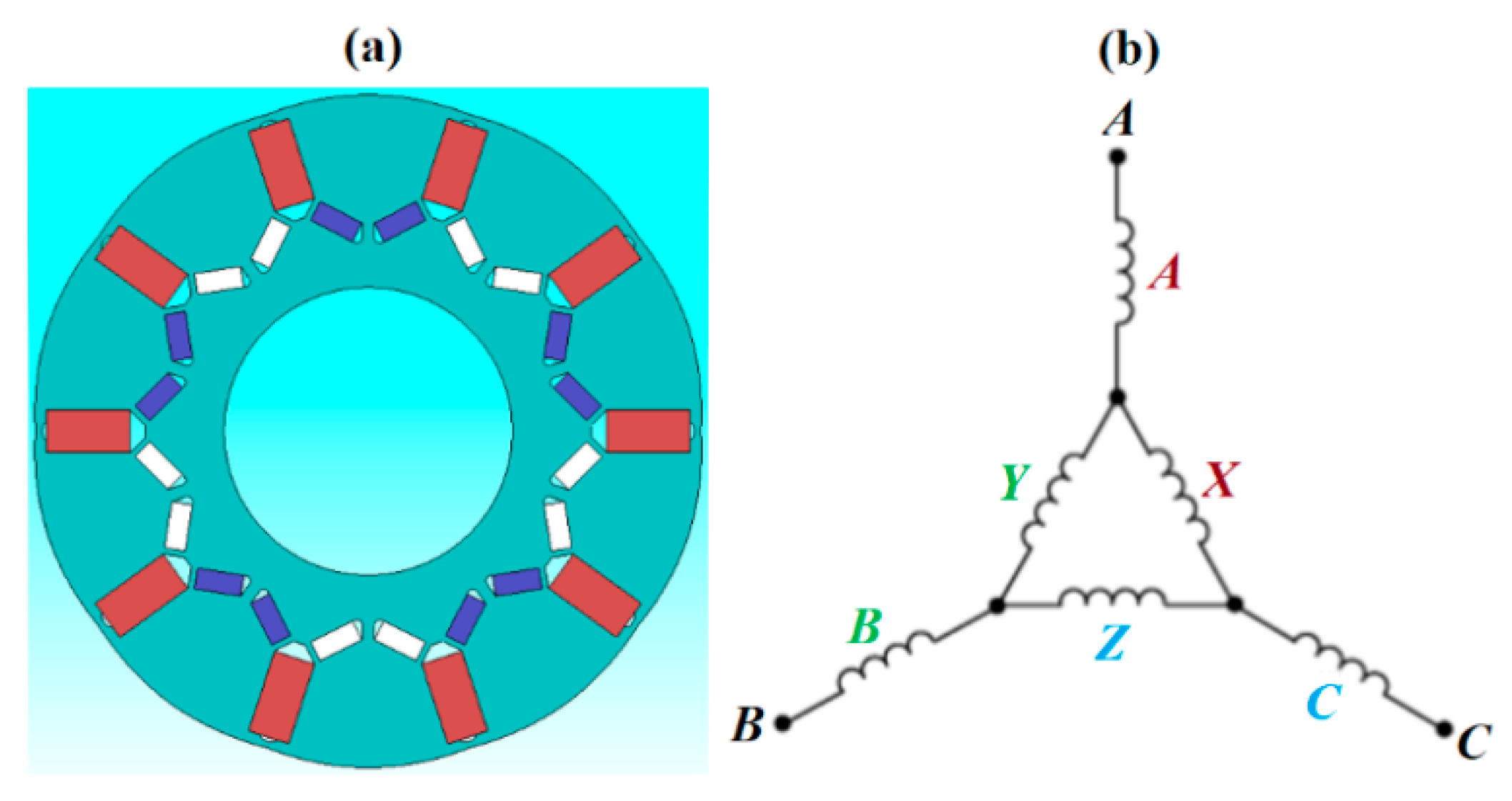
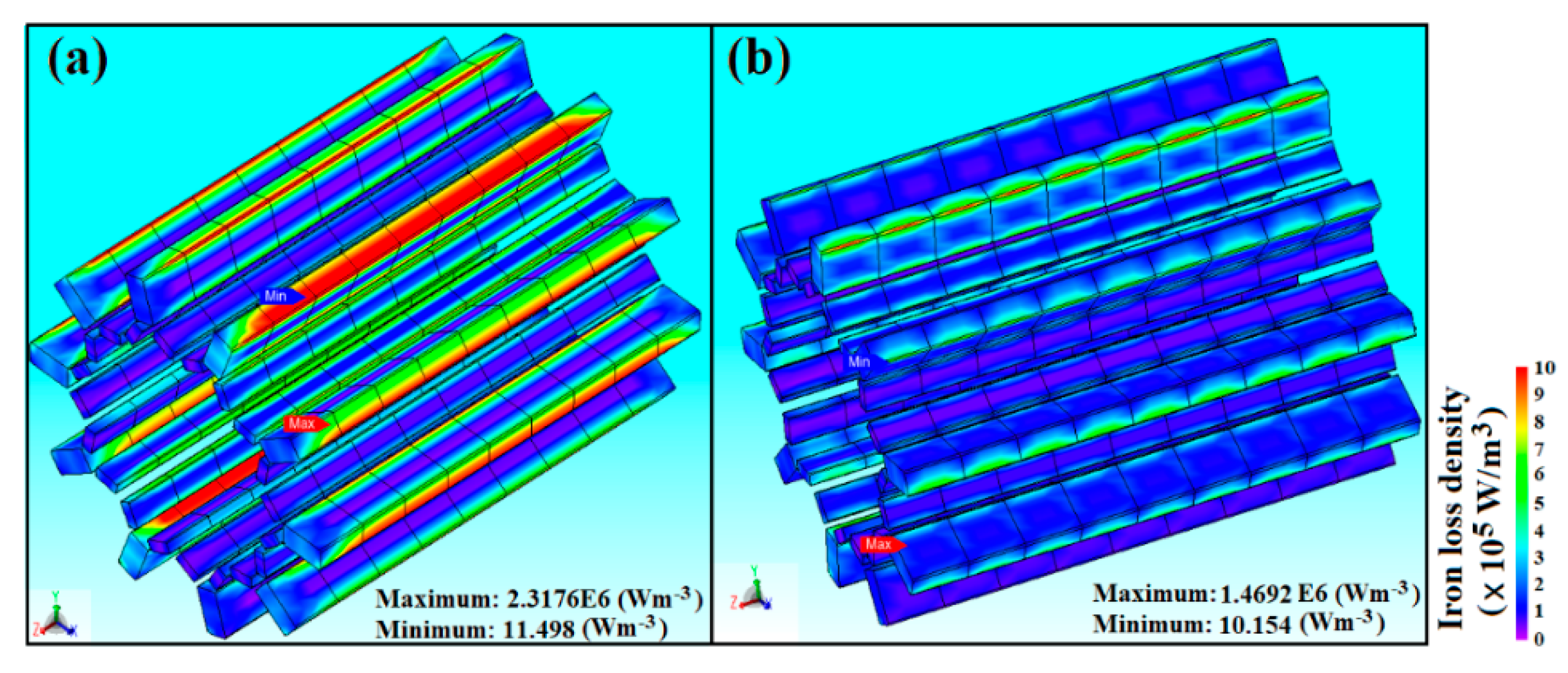
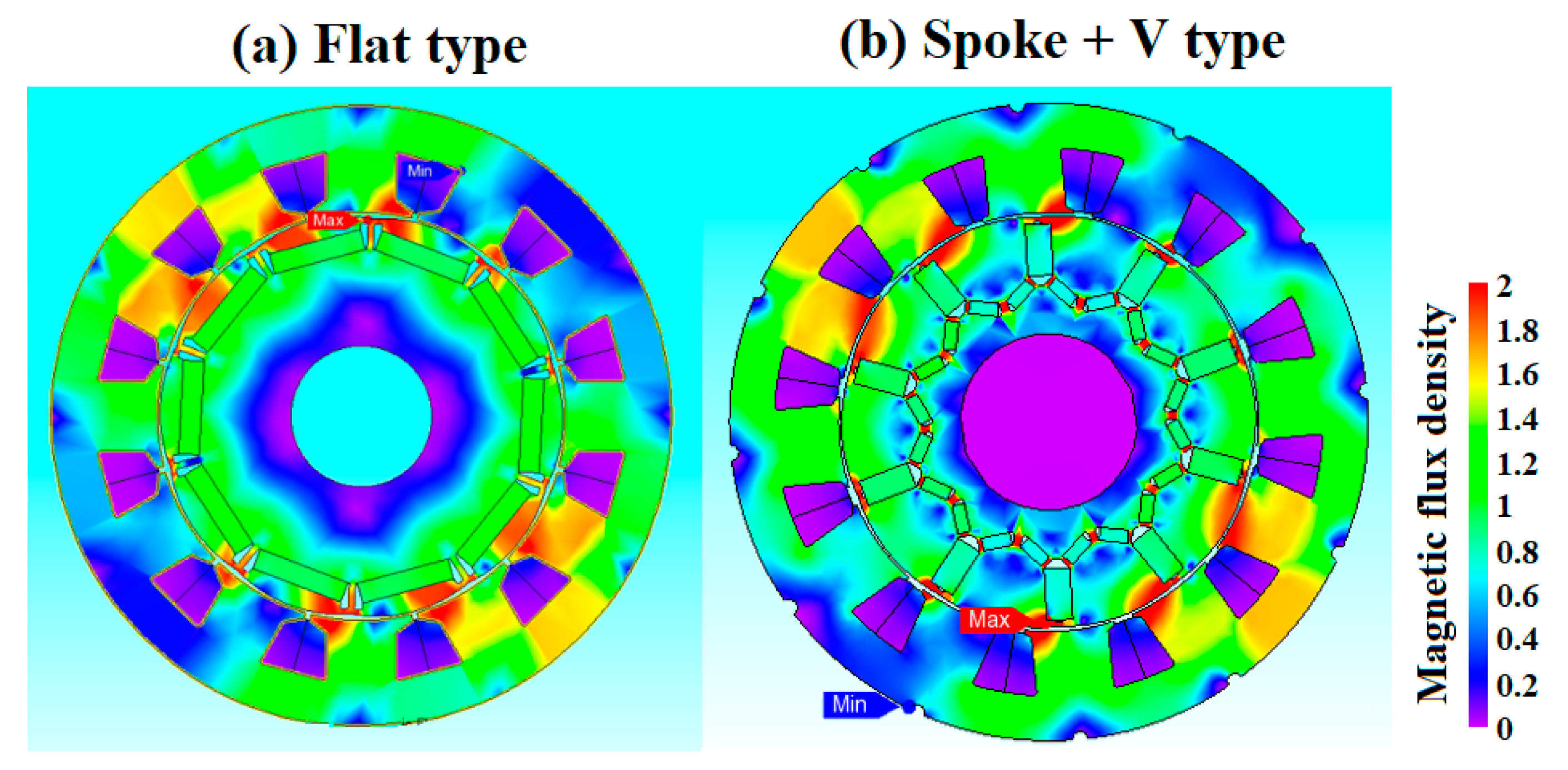



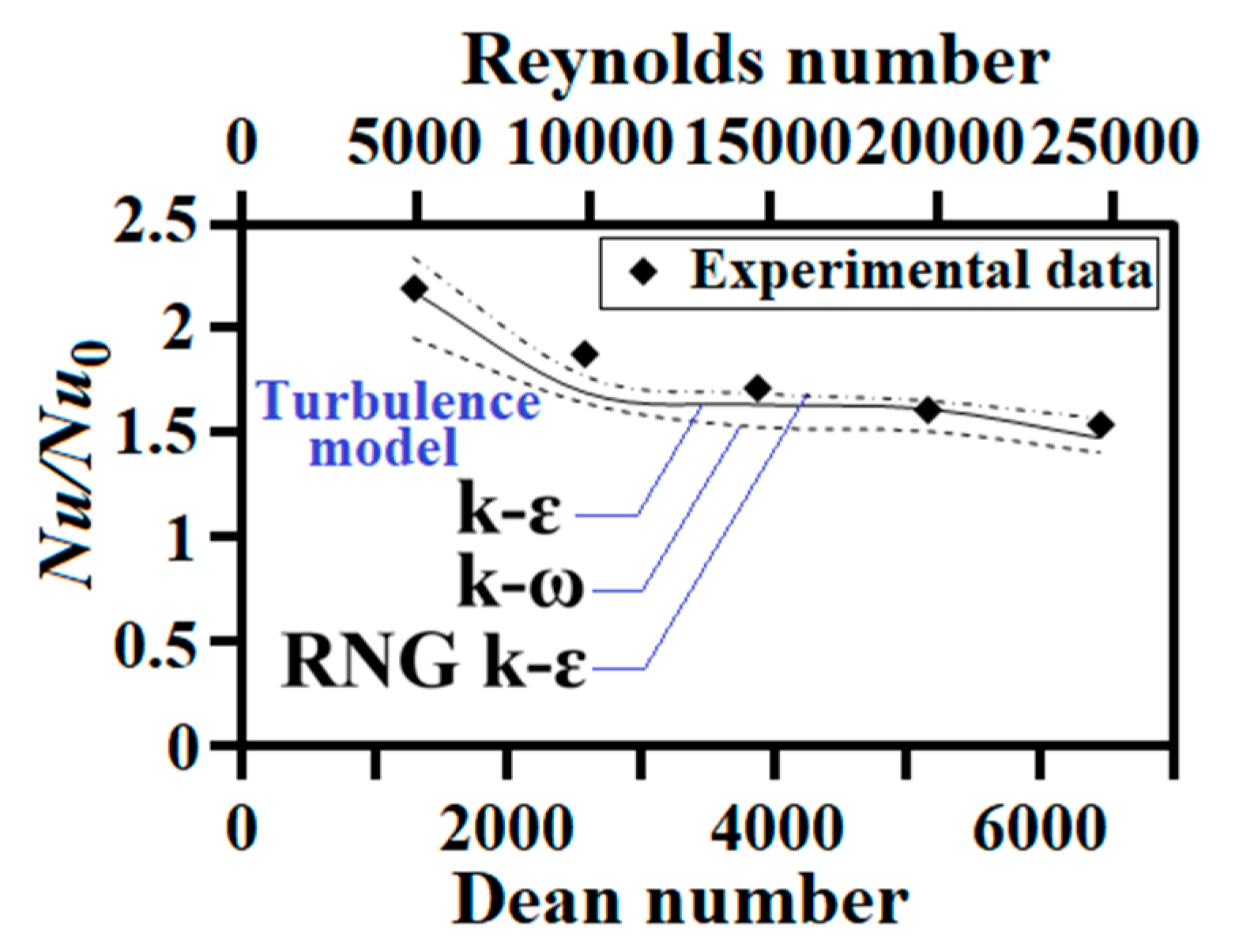
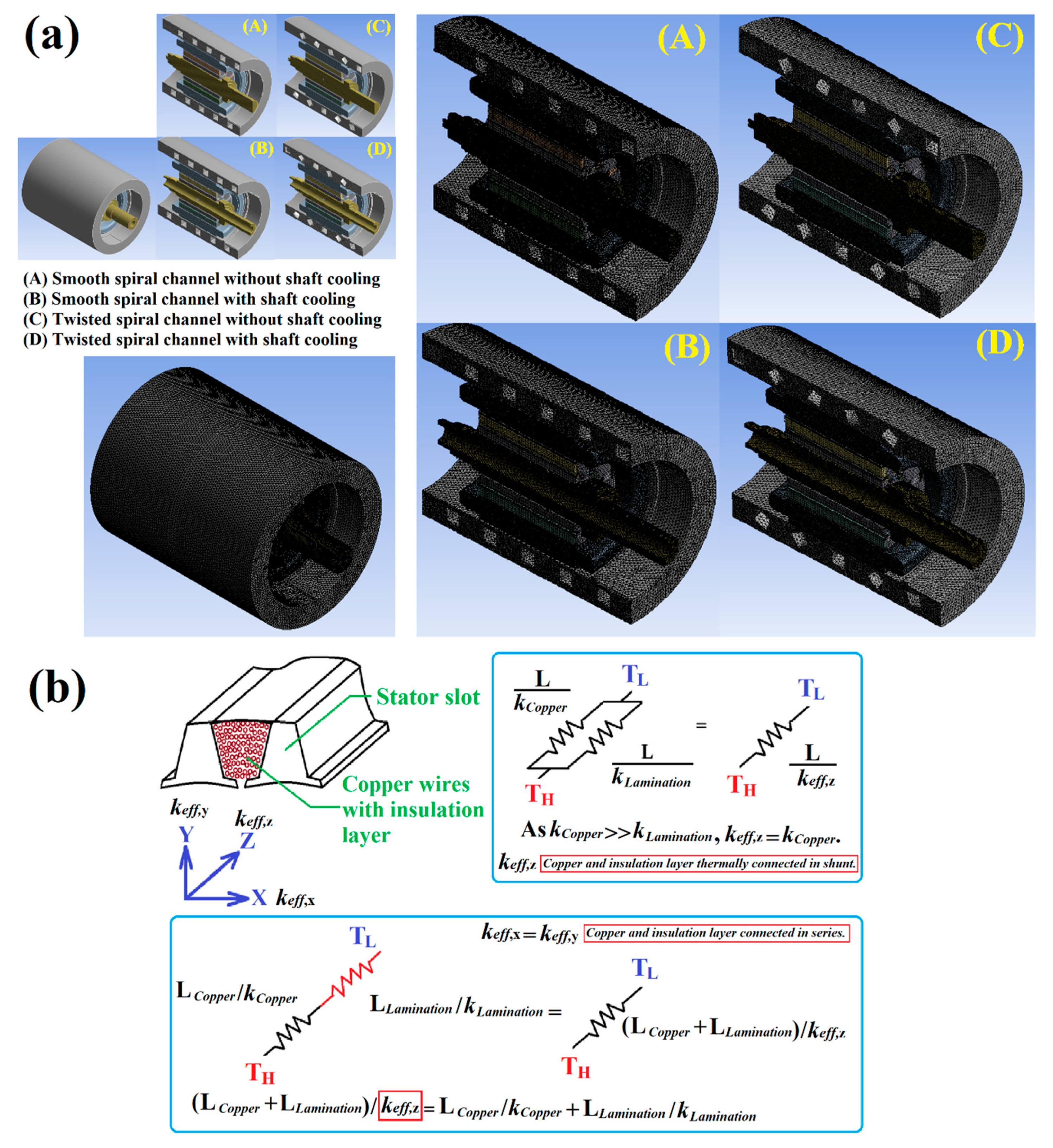
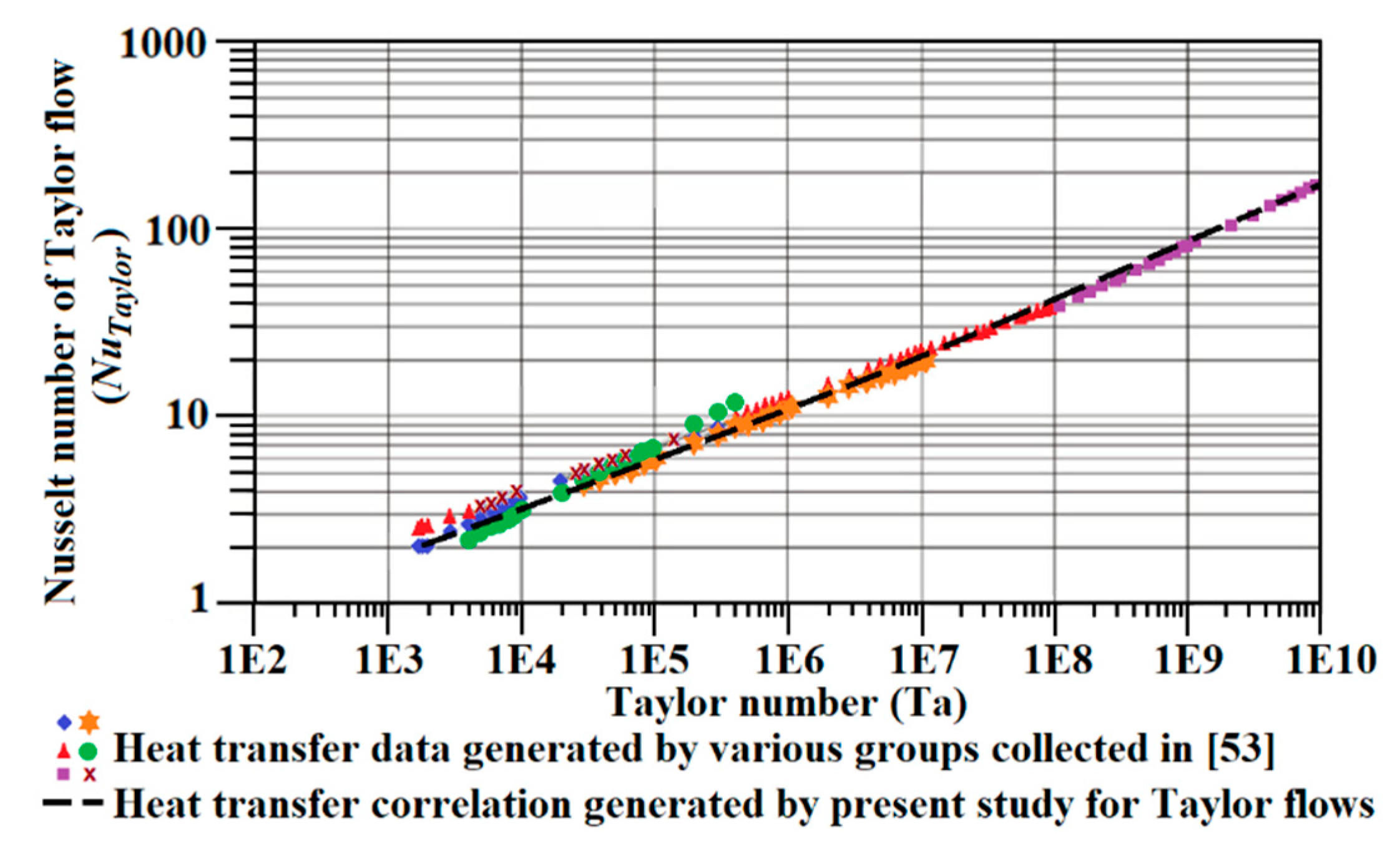
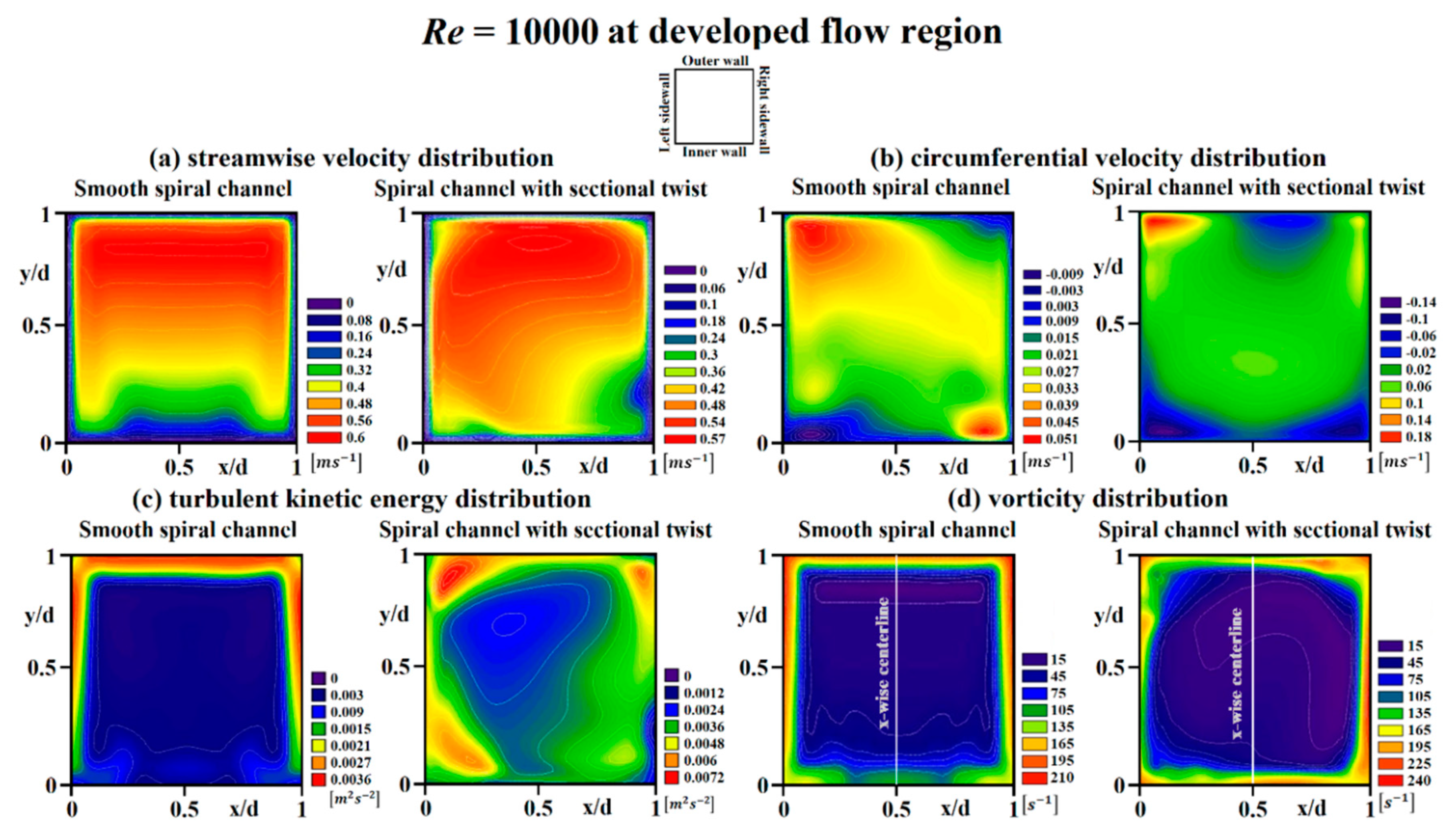
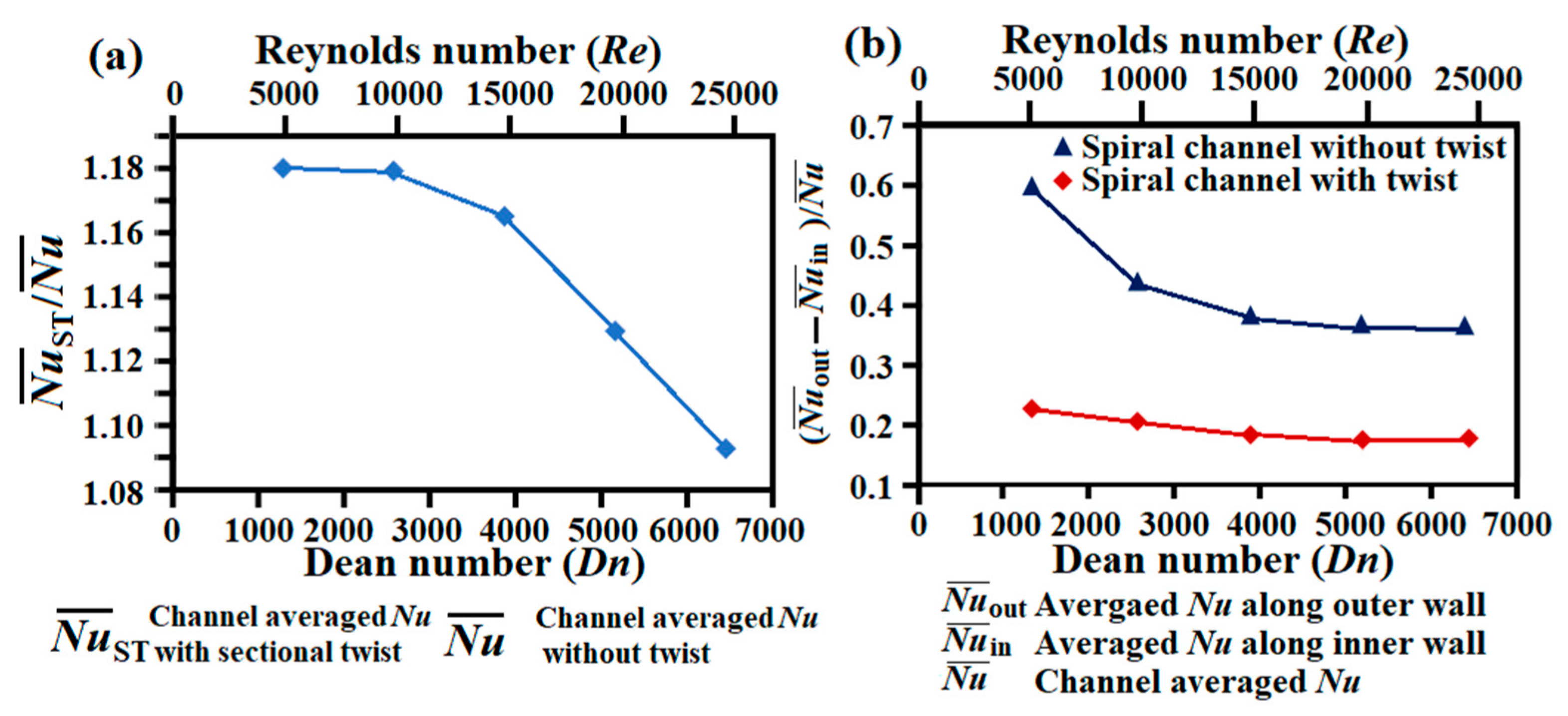
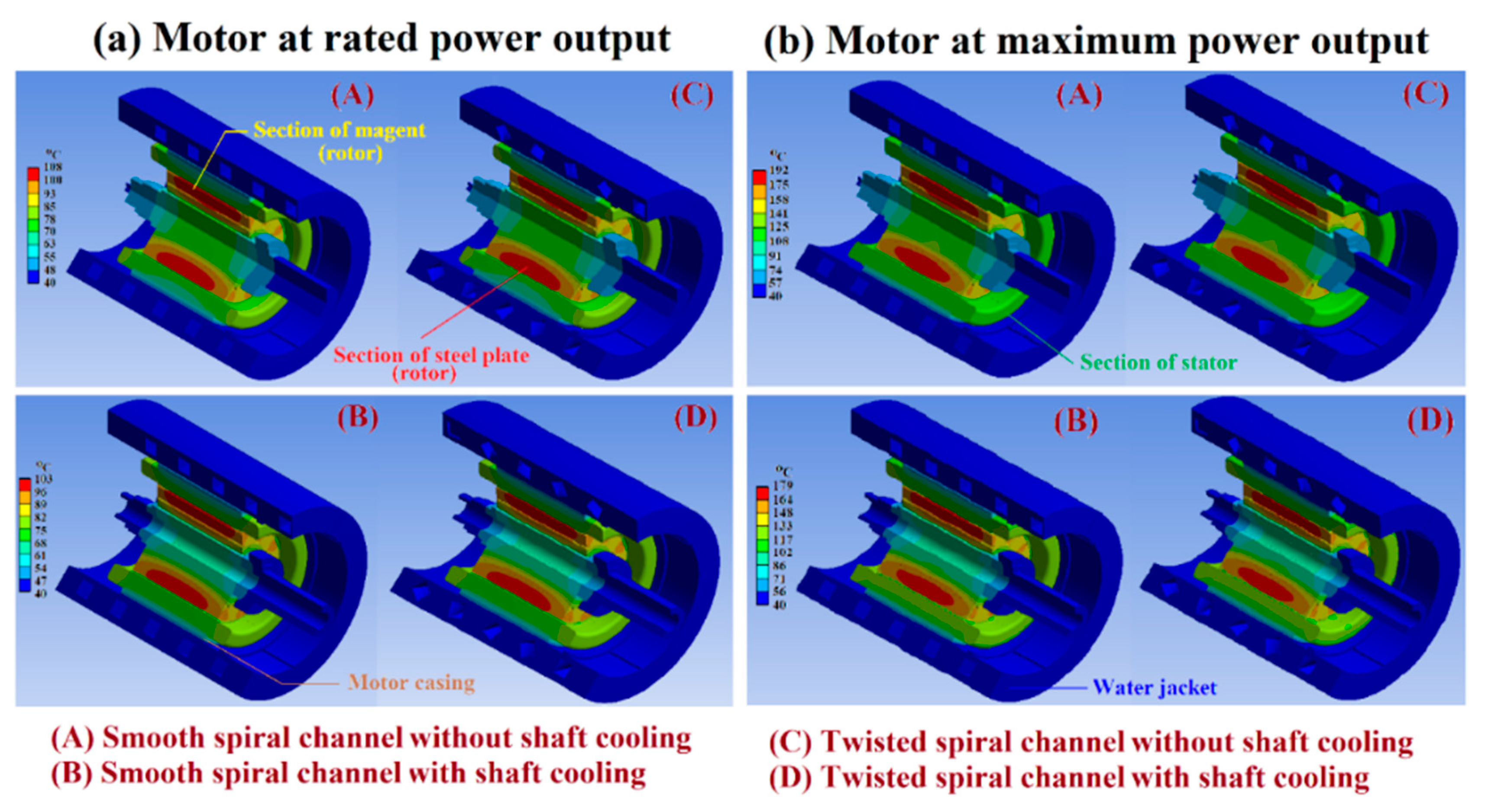
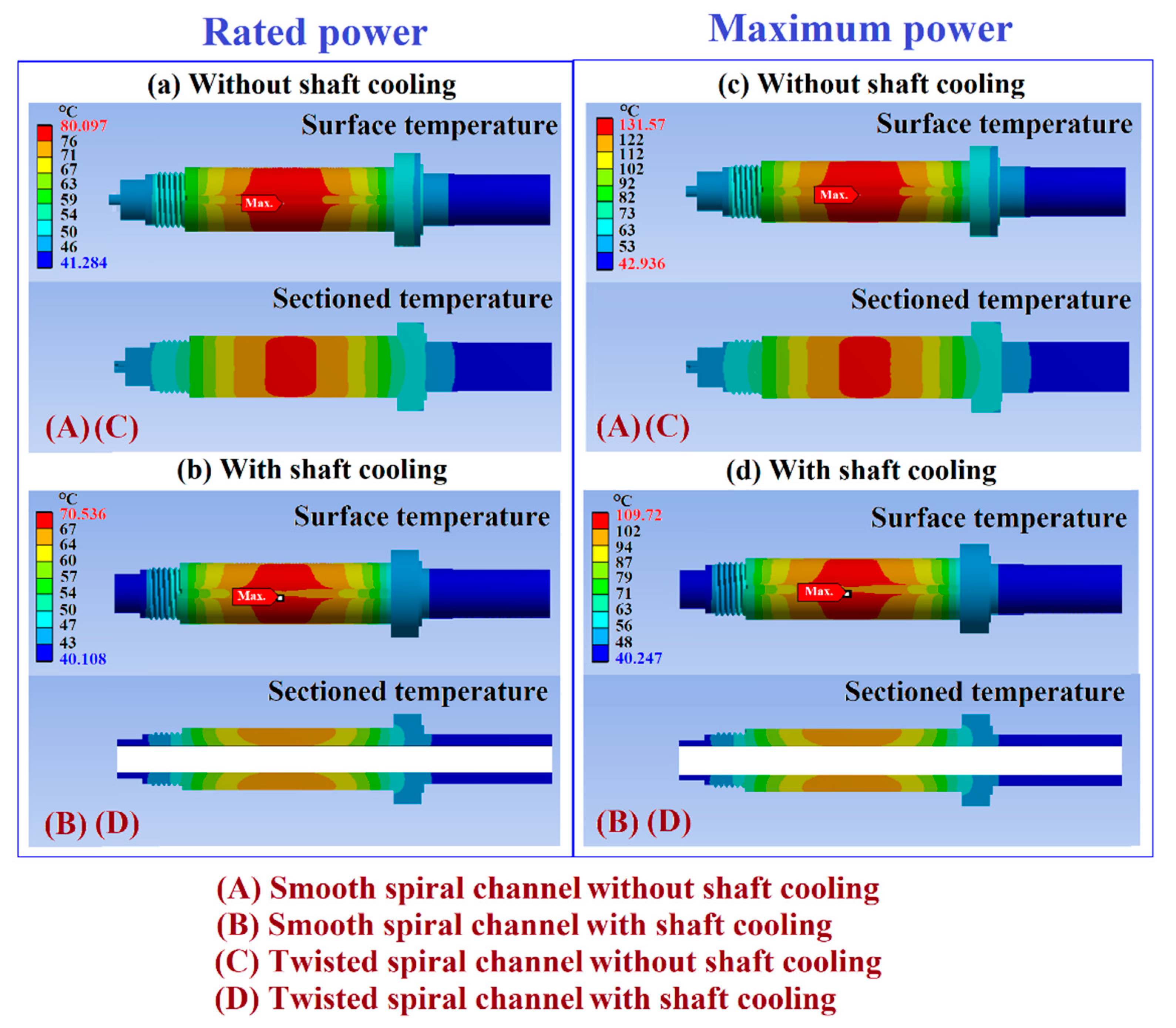

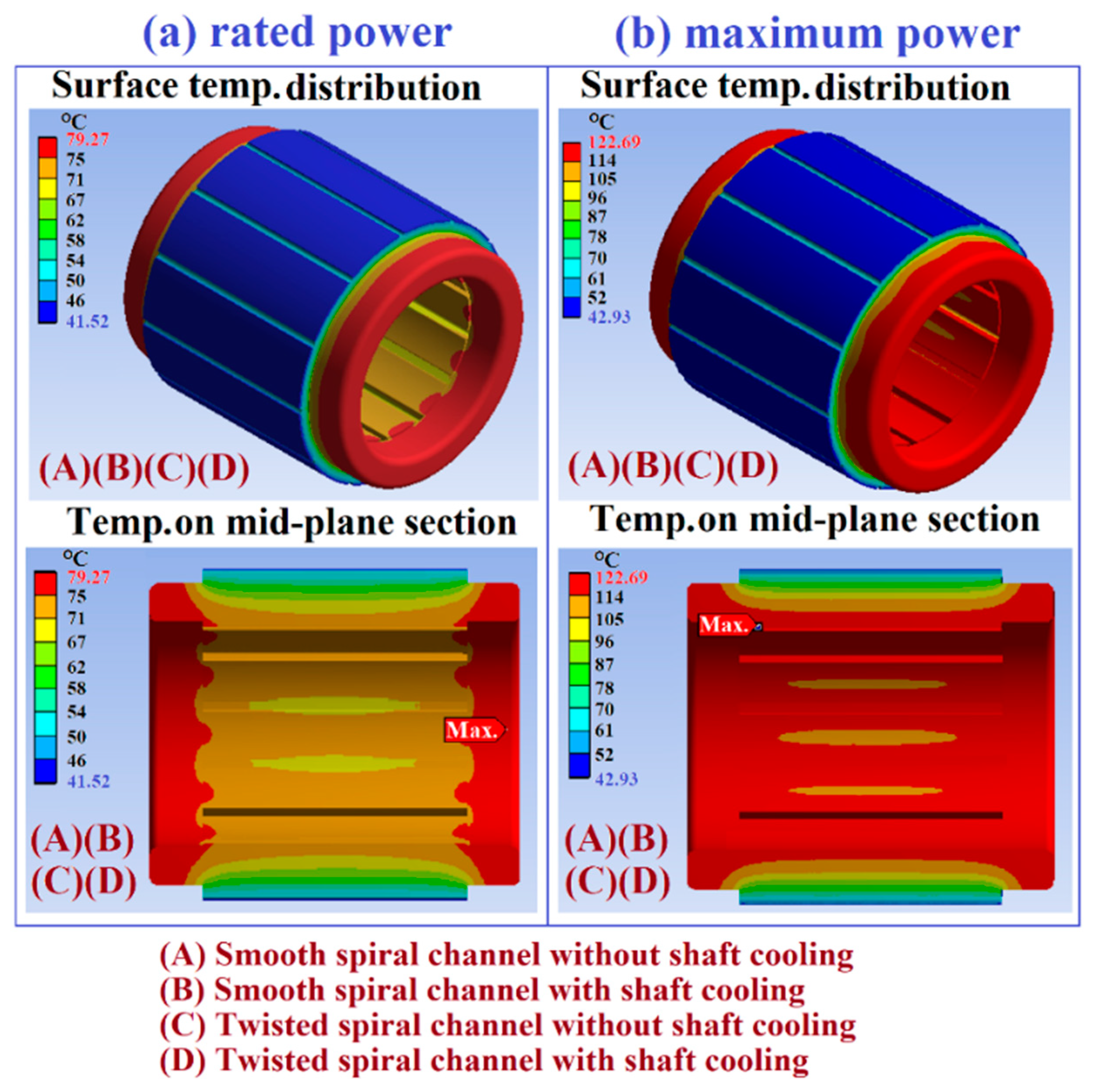
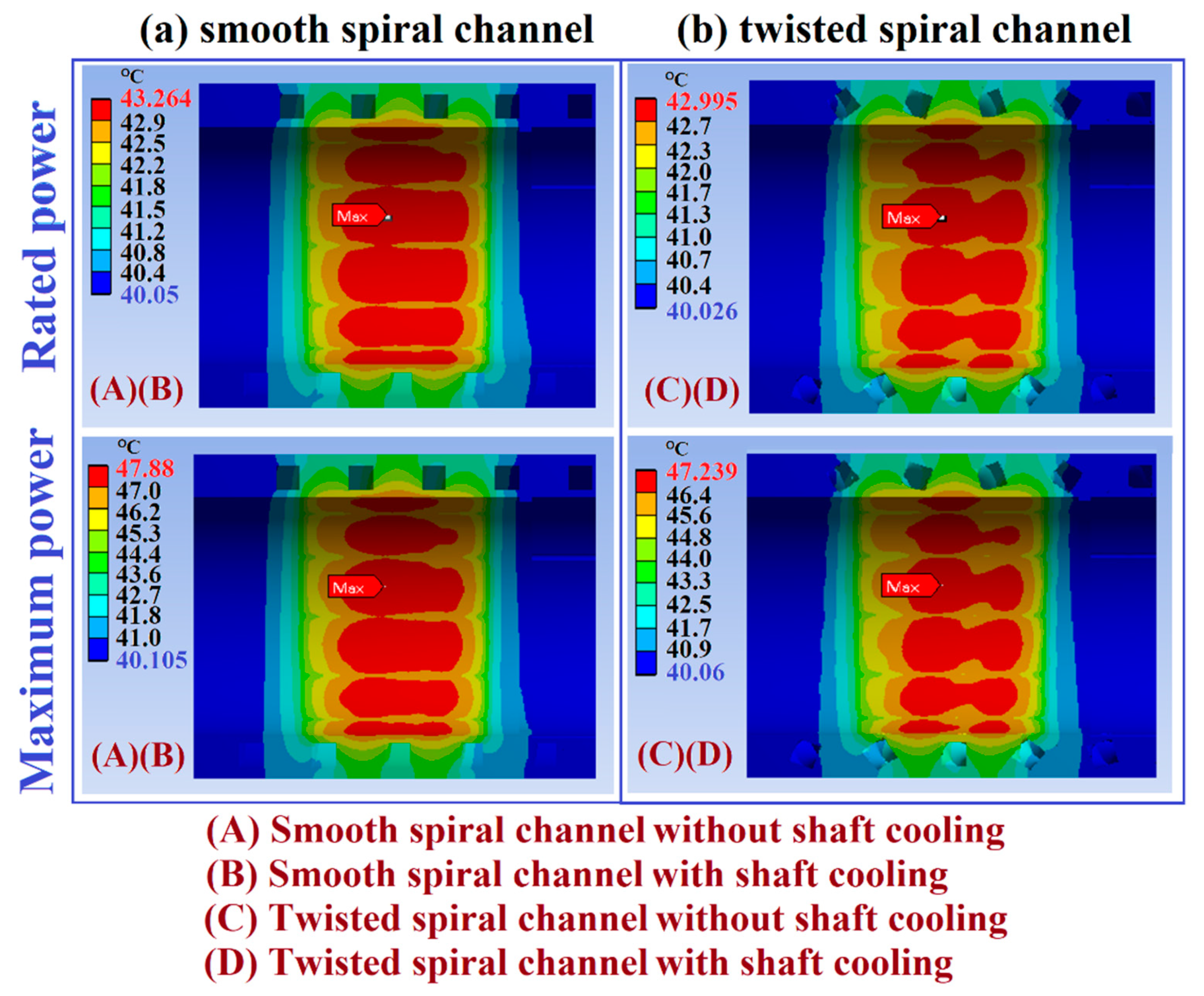
| Electromagnetic Design Specifications for the FSCW Motor | |||
|---|---|---|---|
| Slot fill factor (%) | 61 | Max. Torque (Nm) | 240 |
| Rated current density (A/mm2) | 12 | Max. Power (kW) | 120 |
| Current at rated condition (A) | 212 | Rated. Power (kW) | 80 |
| Current at max. condition (A) | 424 | Rated Speed (rpm) | 6000 |
| Rated Toque (Nm) | 120 | Max. Speed (rpm) | 11,000 |
| Power Density (kW/kg) | 3.6 | Operation at max. condition | 30 |
| Simulation Conditions | Spoke + V | Flat | Simulation Results | Spoke + V | Flat |
|---|---|---|---|---|---|
| Base speed (rpm) | 6000 | 6240 | Rated Torque (Nm) | 124 | 111 |
| Voltage (V) | 400 | 400 | Rated Power (kW) | 80 | 78 |
| Max. Current (A) | 600 | 600 | Total Rotor Loss (W) | 1000 | 1500 |
| Max. Torque (Nm) | 240 | 216 |
| Motor Losses at Rated Operation/6000 rpm/Unlimited Seconds | |||
| Rotor Iron loss (W) | 250 | Stator Iron loss (W) | 650 |
| Magnet loss (W) | 300 | Copper loss (W) | 550 |
| Motor Losses at Max. Operation at 6000 rpm | |||
| Rotor Iron loss (W) | 571 | Stator Iron loss (W) | 953 |
| Magnet loss (W) | 934 | Copper loss (W) | 2200 |
© 2019 by the authors. Licensee MDPI, Basel, Switzerland. This article is an open access article distributed under the terms and conditions of the Creative Commons Attribution (CC BY) license (http://creativecommons.org/licenses/by/4.0/).
Share and Cite
Wu, P.-S.; Hsieh, M.-F.; Cai, W.L.; Liu, J.-H.; Huang, Y.-T.; Caceres, J.F.; Chang, S.W. Heat Transfer and Thermal Management of Interior Permanent Magnet Synchronous Electric Motor. Inventions 2019, 4, 69. https://doi.org/10.3390/inventions4040069
Wu P-S, Hsieh M-F, Cai WL, Liu J-H, Huang Y-T, Caceres JF, Chang SW. Heat Transfer and Thermal Management of Interior Permanent Magnet Synchronous Electric Motor. Inventions. 2019; 4(4):69. https://doi.org/10.3390/inventions4040069
Chicago/Turabian StyleWu, Pey-Shey, Min-Fu Hsieh, Wei Ling Cai, Jen-Hsiang Liu, Yun-Ting Huang, Jose Fernando Caceres, and Shyy Woei Chang. 2019. "Heat Transfer and Thermal Management of Interior Permanent Magnet Synchronous Electric Motor" Inventions 4, no. 4: 69. https://doi.org/10.3390/inventions4040069
APA StyleWu, P.-S., Hsieh, M.-F., Cai, W. L., Liu, J.-H., Huang, Y.-T., Caceres, J. F., & Chang, S. W. (2019). Heat Transfer and Thermal Management of Interior Permanent Magnet Synchronous Electric Motor. Inventions, 4(4), 69. https://doi.org/10.3390/inventions4040069







